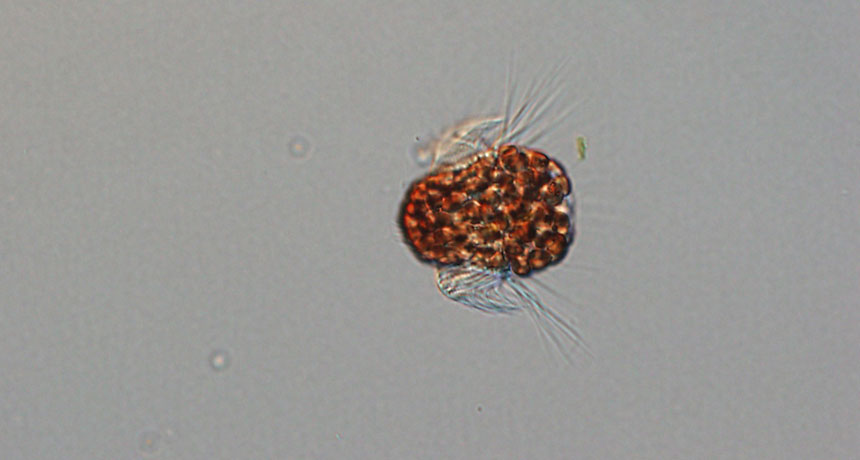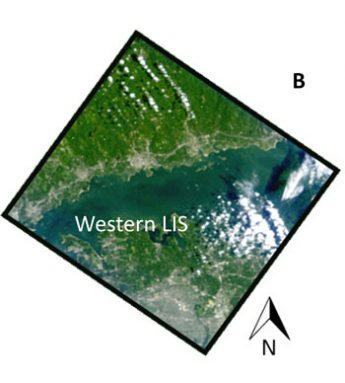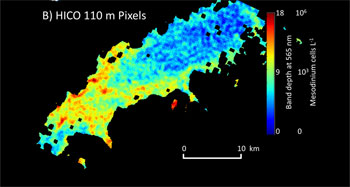Scientists identify plankton from space
A sensor on the International Space Station caught a red tide in progress

This organism is a species of plankton called Mesodinium rubrum. Each is very tiny. But when they multiply rapidly, plankton can form large blooms that turn the ocean surface green, red or brown. Some blooms are so large that satellites can spy them from space.
H. Dierssen et al/PNAS
Plankton — tiny organisms drifting in the sea — often are too small to see without a microscope. But with the help of some math and a very powerful imaging device, scientists for the first time have identified a species of plankton from space. Finding out which plankton are proliferating can help researchers learn more about toxic threats in the ocean. For instance, it might help determine if your nearest beach should be closed owing to poisons shed by those microbes.
Plankton in the ocean often bloom — undergo short periods of rapid reproduction. The tiny organisms can increase so quickly that they form a mass big enough to change the color of the water. Affected water can turn red, brown or even green. Regardless of the color, all of these blooms are still called “red tides.”
Some blooms can prove harmful to the environment. They can reduce the amount of sunlight that reaches other organisms. And they can deplete waters of the oxygen that fish and other species need to survive. But some blooms are particularly dangerous for people. That’s because these plankton make a toxin, or poison. Toxins can kill fish, make it hard for some people to breathe and taint the shellfish destined for dinner tables. When health officials are uncertain which species of plankton is behind a bloom, many play it safe and close beaches.

Dierssen and her colleagues collect water samples from Long Island Sound, the water separating New York and Connecticut. It’s an estuary, where fresh and saltwater mix. Back in the lab, her team uses microscopes to scout for plankton. But because the researchers head out only once a month, they usually miss sudden blooms, even huge ones.
A lucky strike from space
But on September 24, 2012, “one of our colleagues had been out to sea, and she had seen this large bloom,” Dierssen recalls. “[She] collected some water for us and brought it back.”
At the same time, Dierssen was looking through images of the ocean captured from space. A camera aboard the International Space Station had snapped pictures of the same area of Long Island Sound — on the same day.
That camera is called the Hyperspectral Imager for the Coastal Ocean, or HICO. This spectrometer analyzes wavelengths (colors) of light. HICO was designed specifically to study light from coastal areas.
Most imagers in space “see” only about one square kilometer (0.4 square mile) per pixel. Pixels are the tiniest dots of light on a computer screen. Pictures emerge from viewing thousands of pixels or more. The smaller the area represented by each pixel, the more detailed an image will become.

So when Dierssen studied the image from the space station, she was able to pick out the same red tide that her colleague had just sampled. “We were lucky,” she adds, because HICO “is no longer operational.” It had only been working a short time as part of a test. Another imager also captured the image, but in far less detail.
Seeing yellow, finding red
Green algae and plants possess chloroplasts (KLOR-oh-plasts). These tiny structures turn sunlight into energy. Being fluorescent, chloroplasts absorb some light, then emit a share of it back into space. Most of them emit light that the imager would read as reddish.
But one type does not. These chloroplasts contain phycoerythrin (FY-ko-eh-RITH-rin). This pigment emits light that the imager sees as yellow. HICO detected that color coming off of Long Island Sound.
Based on that yellow “flag,” Diersson and her colleagues could tell which species of plankton had made it: Mesodinium rubrum (MEZ-oh-DIN-ee-uhm RU-brum). M. rubrum is a zooplankton (ZO-plank-tun), a tiny animal that eats algae. And when it does, this animal keeps their chloroplasts, using them to get extra energy from the sun. It was the algal chloroplasts that these plankton had eaten that had emitted the yellowish glow seen from space.
Diersson’s team confirmed the animal’s ID with its microscopes. M. rubrum does not make toxins. So this red tide posed no danger to swimmers, shellfish or human diners.
The researchers also analyzed the genes — segments of DNA that are unique to each species — of the blooming plankton. These confirmed that the species was M. rubrum. The scientists published their findings November 16 in the Proceedings of the National Academy of Sciences.
“We could see the [red tide] from space,” Dierrsen says. “It’s the first time anyone’s ever done that.” While HICO is no longer working, Dierrsen hopes that future satellite sensors will allow scientists to similarly keep a spying eye out for plankton blooms.
Limitations on the technology
The new study “is a solid paper that addresses a current and topical issue,” say Leslie Brown and Gary Borstad. Both work at ASL Environmental Sciences in Victoria, British Columbia, Canada. They look for changes in the environment that can be detected from very long distances, including from space.
Brown and Borstad think it might be too risky to identify red tides solely from space. There needs to be microscopic identification of what’s causing a bloom, they explain, “especially when human health is involved.” But both agree that satellites and other space-based sensors could offer a valuable early warning of what deserves further study.
“Ships miss these big events,” Deirssen says. With spying eyes in space, “We can find out a lot about what’s growing in the ocean. It can help us find out why [plankton] bloom when they do.”
Power Words
(for more about Power Words, click here)
algae Single-celled organisms, once considered plants (they aren’t). As aquatic organisms, they grow in water. Like green plants, they depend on sunlight to make their food.
bloom (in microbiology) The rapid and largely uncontrolled growth of a species, such as algae in waterways enriched with nutrients.
brackish A term for water that contains a mixture of saltwater and freshwater.
chloroplast A tiny structure in the cells of green algae and green plants that contain chlorophyll and creates glucose through photosynthesis.
environment The sum of all of the things that exist around some organism or the process and the condition those things create for that organism or process. Environment may refer to the weather and ecosystem in which some animal lives, or, perhaps, the temperature, humidity and placement of components in some electronics system or product.
estuary The mouth of a large river, where it empties into the ocean and freshwater and saltwater mix. Such regions are often nurseries for young fish.
fluorescent Capable of absorbing and reemitting light. That reemitted light is known as a fluorescence.
gene (adj. genetic) A segment of DNA that codes, or holds instructions, for producing a protein. Offspring inherit genes from their parents. Genes influence how an organism looks and behaves.
International Space Station An artificial satellite that orbits Earth. Run by the United States and Russia, this station provides a research laboratory from which scientists can conduct experiments in biology, physics and astronomy — and make observations of Earth.
microbe Short for microorganism. A living thing that is too small to see with the unaided eye, including bacteria, some fungi and many other organisms such as amoebas. Most consist of a single cell.
microscope An instrument used to view objects, like bacteria, or the single cells of plants or animals, that are too small to be visible to the unaided eye.
NASA See National Aeronautics and Space Administration
National Aeronautics and Space Administration Created in 1958, this U.S. agency has become a leader in space research and in stimulating public interest in space exploration. It was through NASA that the United States sent people into orbit and ultimately to the moon. It has also sent research craft to study planets and other celestial objects in our solar system.
optics Having to do with vision or what can be seen.
organism Any living thing, from elephants and plants to bacteria and other types of single-celled life.
oxygen A gas that makes up about 21 percent of the atmosphere. All animals and many microorganisms need oxygen to fuel their metabolism.
photosynthesis (verb: photosynthesize) The process by which green plants and some other organisms use sunlight to produce foods from carbon dioxide and water.
phycoerythrin A protein that can harvest light energy from the sun. It is found in red algae.
phytoplankton Sometimes referred to as microalgae, these are microscopic plants and plant-like organisms that live in the ocean. Most float and reside in regions where sunlight filters down. Much like land-based plants, these organisms contain chlorophyll. They also require sunlight to live and grow. Phytoplankton serve as a base of the oceanic food web.
pixel Short for picture element. A tiny area of illumination on a computer screen, or a dot on a printed page, usually placed in an array to form a digital image. Photographs are made of thousands of pixels, each of different brightness and color, and each too small to be seen unless the image is magnified.
plankton Small organisms that drift or float in the sea. Depending on the species, plankton range from microscopic sizes to organisms about the size of a flea. Some are tiny animals. Others are plantlike organisms. Although individual plankton are very small, they form massive colonies, numbering in the billions. The largest animal in the world, the blue whale, lives on plankton.
Proceedings of the National Academy of Sciences A prestigious journal publishing original scientific research, begun in 1914. The journal’s content spans the biological, physical, and social sciences. Each of the more than 3,000 papers published each year, now, not only is peer reviewed but also approved by a member of the U.S. National Academy of Sciences.
red tide A population explosion of certain species of plankton. When enough are present, they can color the water red or reddish-brown. Some secrete a poison that can kill surrounding fish and make people sick.
satellite A moon orbiting a planet or a vehicle or other manufactured object that orbits some celestial body in space.
species A group of similar organisms capable of producing offspring that can survive and reproduce.
spectrometer An instrument that measures a spectrum, such as light, energy, or atomic mass. Typically, chemists use these instruments to measure and report the wavelengths of light that it observes. The collection of data using this instrument, a process is known as spectrometry, can help identify the elements or molecules present in an unknown sample.
toxin A poison produced by living organisms, such as germs, bees, spiders, poison ivy and snakes.
wavelength The distance between one peak and the next in a series of waves, or the distance between one trough and the next. Visible light — which, like all electromagnetic radiation, travels in waves — includes wavelengths between about 380 nanometers (violet) and about 740 nanometers (red). Radiation with wavelengths shorter than visible light includes gamma rays, X-rays and ultraviolet light. Longer-wavelength radiation includes infrared light, microwaves and radio waves.
zooplankton Small organisms that drift in the sea. Zooplankton are tiny animals that eat other plankton. They also serve as an important food source for other marine creatures.







